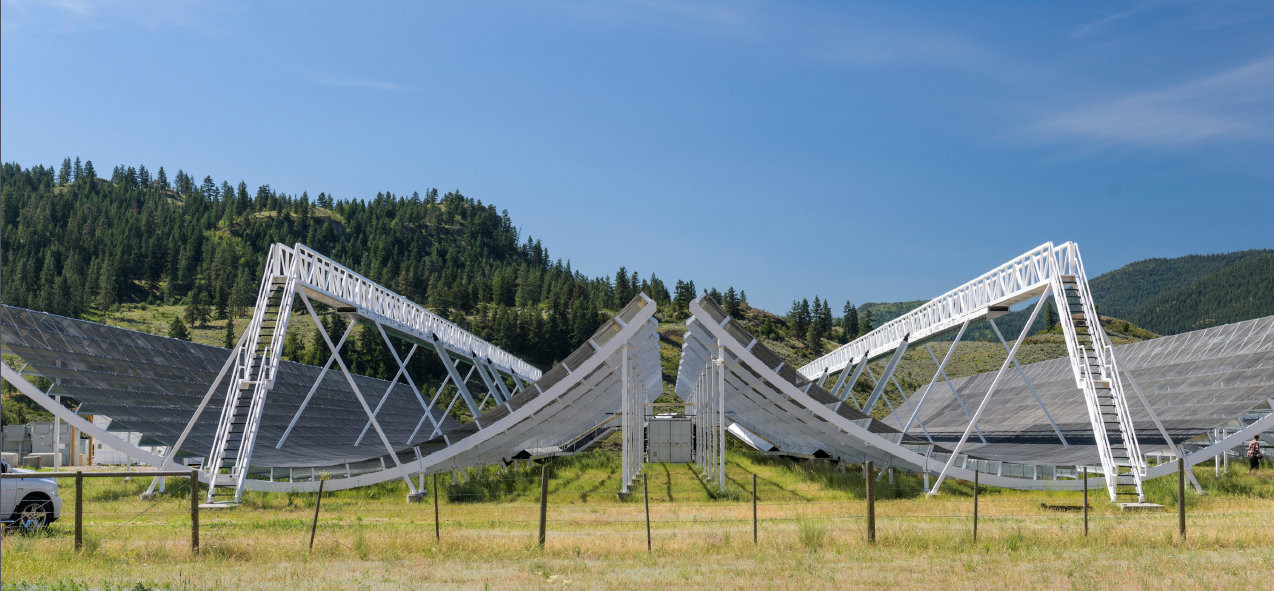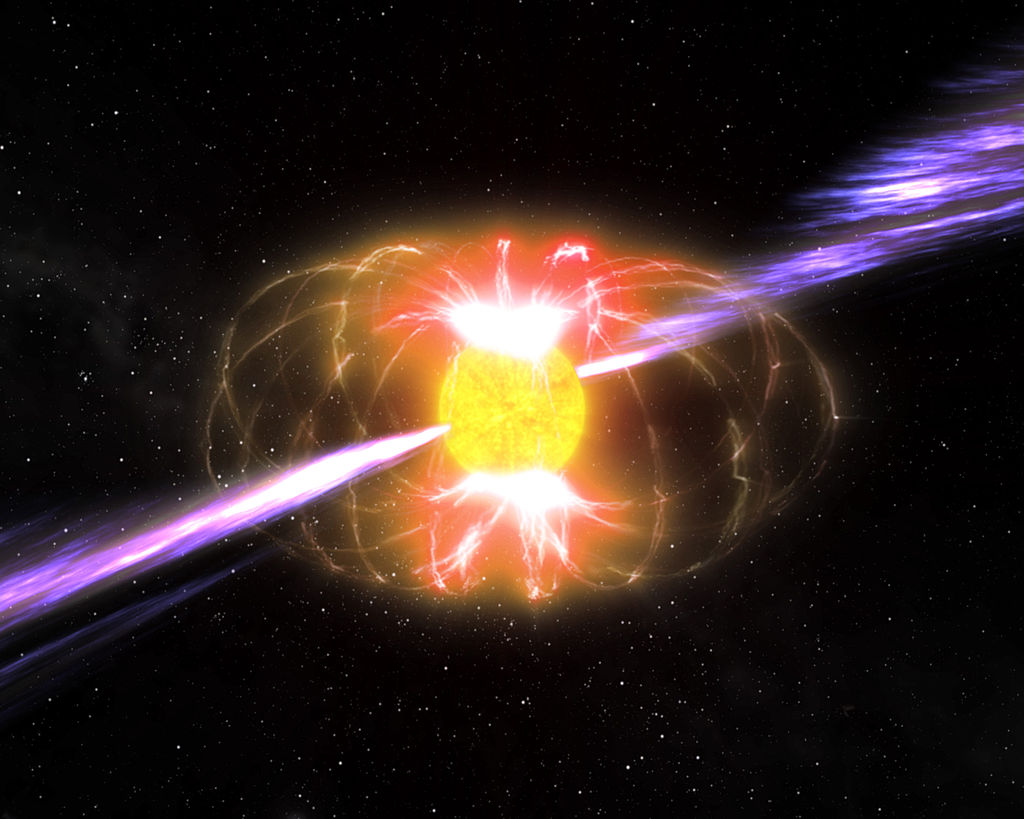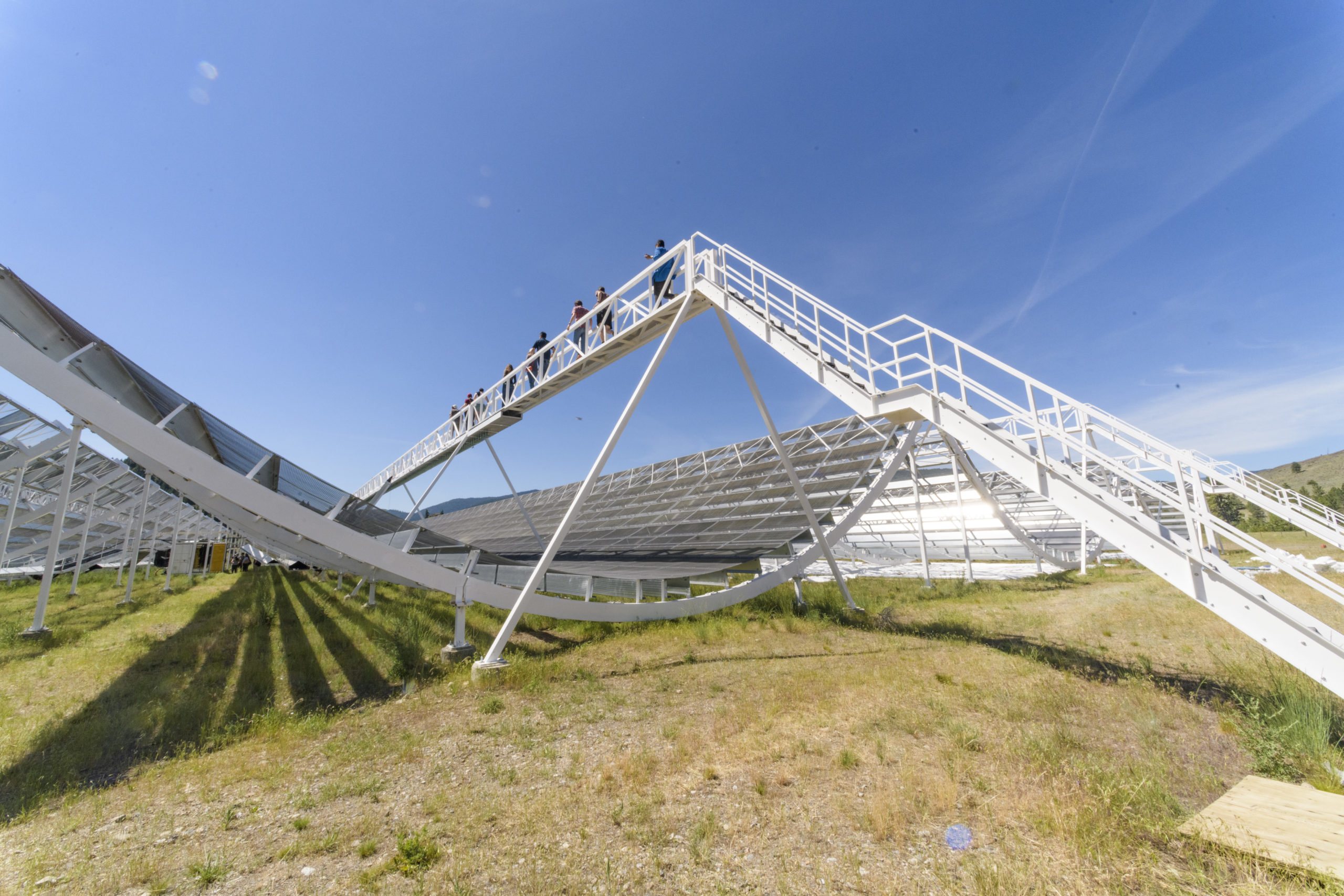By: Jon Farrow
16 Sep, 2020

New results from fellows in CIFAR’s Gravity & the Extreme Universe program and the CHIME telescope collaboration continue to provide unique astrophysical insights
Fast Radio Bursts (FRBs) are intense, millisecond-long flashes of radio waves from outer space that, since their discovery in 2007, have defied explanation.
“We don’t know what they are,” says Victoria Kaspi, R. Howard Webster Foundation Fellow, director of CIFAR’s Gravity & the Extreme Universe program, and professor at McGill University. “If we knew, it wouldn’t be any fun. [The mystery] is why this is so interesting. But there’s a lot of evidence piling up.”
Too powerful to be a simple star explosion and too common to be something exotic like neutron star mergers, the origin of FRBs has remained an unresolved astrophysical puzzle. But as the Canadian Hydrogen Mapping Experiment (CHIME) continues to find more examples, the possibilities for what causes these intergalactic flares are narrowing.

While CHIME was originally conceived as an instrument to map the large scale structure of hydrogen in the Universe (a task which it continues to excel at), Kaspi and her colleagues in CIFAR’s Gravity & the Extreme Universe program have been deeply involved in the adaptation of the telescope to search for FRBs. It was conversations at CIFAR meetings between fellows that led the astronomers to realize the instrument would be an excellent FRB detector. Its long troughs and peculiar design enable it to find dozens of FRBs by patiently staring at big patches of the sky.
“When you build a new and powerful instrument, as we have done, you dream that this power will also let you solve new puzzles you had not anticipated,” says Mark Halpern, a fellow in the Gravity & the Extreme Universe program, professor of physics at the University of British Columbia, and a principal investigator on the CHIME telescope. “That dream has come true here.”
A whole new data infrastructure had to be programmed and built, which is the part of the project Matt Dobbs, also a fellow in the program and a professor at McGill University, works on. “The raw data rate of CHIME, what we’re actually sending into our electronics, is enormous. It’s 13.2 terabits per second,” says Dobbs. “When we built the [system], that was larger than the entire world’s mobile data traffic.”
“CIFAR has played a pivotal role in catalyzing the development of the CHIME radio telescope,” writes Gary Hinshaw, a fellow in the program and professor at the University of British Columbia, in the 2020 fellows’ survey. “I left a job at NASA nearly 10 years ago to move to Canada so that I could help found and develop CHIME. I knew at the time that it would be a challenging, novel, and fun project with tremendous scientific potential. I have never regretted this move, and being part of CIFAR has made it even better.”
In 2018, before CHIME turned on its receivers, it was commonly observed that there were more theories about the origin of FRBs than detections.
Watch Vicky Kaspi discuss the mystery of FRBs in November 2018, before CHIME revolutionized the field.
That all changed within the first few months of CHIME’s preliminary commissioning phase. 13 new bursts discovered by CHIME, one of which repeated, were announced in January 2019. These were the first of CHIME’s findings, and hinted at the deluge of data and discovery that would soon flow.
In August 2019, once CHIME was fully operational, the team announced the discovery of eight more repeating sources. This indicated a possibility that all FRB sources repeat, but some just haven’t been caught in the act more than once. Alternatively, there could be two types of source: those that repeat and those that don’t. Either way, some theories were ruled out; Repeating FRBs couldn’t be caused by catastrophic, one-off events like stellar explosions or mergers.
Five months later, in January 2020, CHIME added another wrinkle to the story when the team reported that one of those repeating sources is periodic. The burst would reappear every 16 days on a schedule so regular, according to Kaspi, “you could set your calendar by it.”
“This one repeating, periodic source discovered with CHIME has been localized to the star forming region on the outskirts of a spiral galaxy,” explains Ingrid Stairs, a fellow in the CIFAR’s Gravity & the Extreme Universe program and a professor at the University of British Columbia. “We don’t know the origin of that 16 day period, but it seems awfully long for any kind of spin.”
Four months after that discovery, in April 2020, CHIME provided another surprise. “In April, during the pandemic, a magnetar in our galaxy suddenly emitted a huge radio burst,” says Kaspi. “Magnetars are highly magnetic neutron stars, and it just so happens I and some of my students who are in the [CHIME] collaboration had worked on them for many years. Nobody had ever seen such a massive signal like that from any magnetar in the Galaxy.”
That event, which the team described in a paper published on a preprint server in May, 2020 and subsequently accepted by Nature, was the first of its kind ever observed.
“First of all, it taught us that magnetars can do that,” says Kaspi. “Second of all, it made it seem not only plausible, but likely that some FRBs in distant galaxies are actually magnetars too. The distant ones would still have to be a little brighter than the one we saw in our galaxy, so it’s not 100% proof, but it’s very suggestive.”

Because CHIME can be set up to monitor the same big patch of sky, night after night, it can wait for interesting astrophysical events, even if astronomers don’t know exactly where or when to look. This makes it an excellent FRB hunter. “It was very likely we would detect hundreds of FRBs. We knew that early on, and indeed that has come to be,” says Kaspi.
The next step is to pull all of the hundreds of detected FRBs into a single catalogue that can be studied for patterns.
Matt Dobbs is particularly excited about the answers that could be gleaned from the population-level statistics of hundreds of well-characterized FRB events. “This new catalogue is going to address for the first time in a systematic way what the distribution of fast radio bursts looks like across the universe, as opposed to zooming in on individual objects,” he says.
Once the catalogue is published for the astrophysics community to pore over, the next big project for astronomers in CIFAR’s Gravity & the Extreme Universe program will be localizing the one-off events.
There are billions of galaxies in the sky, and finding out exactly which one was the source of an FRB requires precision not possible with CHIME alone. “The only FRB that has been really localized from CHIME right now is the [periodic] repeater,” says Stairs. “That’s been localized because we know it repeats and so other telescopes can stare at it and find out where it is.”
Supported by the Gordon & Betty Moore Foundation, the National Science Foundation, and a Catalyst Grant from CIFAR’s Gravity & the Extreme Universe program, CIFAR fellows are planning a series of smaller outrigger telescopes to help triangulate the FRB signals.
The first, in Allenby, B.C., will be 100 kilometres away from CHIME’s base at the Dominion Radio Astrophysical Observatory in Penticton. When this pilot outrigger turns on in late 2021, it will be a proving ground for the complex software that must correlate the vast amount of information being recorded from the sky in multiple locations.
The next step will be to build another mini-CHIME on the other side of the continent, at the Greenbank Observatory in West Virginia.
“With CHIME, we have an 80 metre baseline,” says Dobbs. “But if we put an outrigger out at Greenbank, we would have a three thousand kilometer baseline. That would mean we could figure out not just roughly where [each FRB] is in the sky, but we could localize it to a specific galaxy. And then even better, we could localize within the galaxy—whether they are in the cores of galaxies, the central halos, or the outskirts. That would really help us understand the origin of Fast Radio Bursts.”

Three years after the first light at CHIME, what causes FRBs?
The best answer is that some of the repeating sources of FRBs are likely magnetars, but there may be other phenomena at play. This answer was made possible by bold ideas, collaboration between disciplines, and a team of dedicated scientists including many early-career researchers.
“The success of the whole CHIME FRB project in particular, but also astronomy in general, is really down to all the really terrific postdocs, grad students, and programmers that we have,” says Stairs. “They’ve done amazing work and built this [telescope] from scratch over the course of a few years.”
“This is how science progresses,” says Kaspi. “FRBs are an entirely new astrophysical phenomenon. You can’t solve the entire problem in one day, it doesn’t work that way. You solve it bit by bit, piece by piece. We have been putting pieces of the puzzle together. We don’t have the whole picture yet, but we’re getting there.”

CIFAR’s Gravity & the Extreme Universe program brings together world-leading researchers from astrophysics, cosmology, computational astronomy, and high-energy physics to study the most extreme events in the Universe in order to understand the origin and evolution of the universe.
The CHIME Collaboration includes Gravity & the Extreme Universe program members J. Richard Bond (University of Toronto), Matt Dobbs (McGill), Mark Halpern (University of British Columbia), Gary Hinshaw (University of British Columbia), Victoria Kaspi (McGill University), Ue-Li Pen (University of Toronto), Scott Ransom (National Radio Astronomy Observatory), Ingrid Stairs (University of British Columbia) and Global Scholar alumnus Keith Vanderlinde (University of Toronto)